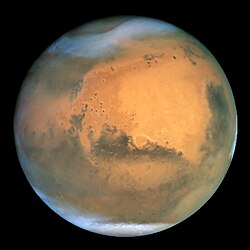Seznam pohoří na Marsu
Toto je seznam pojmenovaných pohoří na Marsu.
Vysvětlivka významů
- Mons znamená obrovská, izolovaná hora.
- Montes je skupina hor tvořící pásové pohoří.
- Tholus znamená malé štítové sopky.
- Tholi je několik tholusů a znamená to skupinu malých hor.
- Dorsa znamená kopce a samotný kopec se nazývá dorsum.
Seznam (tabulka)
| Jméno | Severní šířka (stupeň) | Západní délka (stupeň) | Průměr základny (km)[1] |
|---|---|---|---|
| Alba Patera | 40.4 | 109.6 | 1600 |
| Albor Tholus | 19.3 | 209.8 | 170 |
| Anseris Mons | 58 | ||
| Apollinaris Patera | 296 | ||
| Apollinaris Tholus | 35 | ||
| Arcadia Dorsa | 1900 | ||
| Arsia Mons | -9.4 | 120.5 | 475 |
| Ascraeus Mons | 11.3 | 104.5 | 460 |
| Ausonia Montes | 158 | ||
| Australe Montes | 387 | ||
| Australis Tholus | |||
| Centauri Montes | 270 | ||
| Ceraunius Tholus | 24.2 | 97.2 | 130 |
| Chalce Montes | 95 | ||
| Charitum Montes | -58.3 | 44.2 | 850 |
| Charitum Tholus | |||
| Coronae Montes | 236 | ||
| E. Mareotis Tholus | 5 | ||
| Echus Montes | 6.8 | 78.2 | 395 |
| Elysium Mons | 25.0 | 213.0 | 410 |
| Erebus Montes | 39.9 | 170.5 | 785 |
| Euripus Mons | 91 | ||
| Galaxius Mons | 22 | ||
| Geryon Montes | -8 | 80.7 | 359 |
| Gonnus Mons | 57 | ||
| Hecates Tholus | 32.7 | 209.8 | 183 |
| Hellas Montes | 153 | ||
| Hellespontus Montes | -45.5 | 317.5 | 730 |
| Hibes Montes | 3.9 | 188.9 | 137 |
| Horarum Mons | 20 | ||
| Iaxartes Tholus | |||
| Issedon Tholus | 52 | ||
| Jovis Tholus | 58 | ||
| Kison Tholus | |||
| Labeatis Mons | 23 | ||
| Libya Montes | 2.7 | 271.2 | 1170 |
| Mt. Saint Helens | |||
| N. Mareotis Tholus | 3 | ||
| Nereidum Montes | -41 | 43.5 | 1130 |
| Oceanidum Mons | 33 | ||
| Octantis Mons | 18 | ||
| Olympus Mons - největší známá hora ve sluneční soustavě | 18.4 | 133.1 | 648 |
| Pavonis Mons | 0.3 | 112.8 | 375 |
| Peneus Mons | |||
| Peraea Mons | 22 | ||
| Phlegra Montes | 40.9 | 197.4 | 1352 |
| Pindus Mons | 17 | ||
| Scandia Tholi | 66.0 | 135.4 | 480 |
| Sisyphi Montes | -69.8 | 346.9 | 200 |
| Tanaica Montes | 177 | ||
| Tartarus Montes | 25.1 | 188.7 | 1070 |
| Tharsis Montes | 2.8 | 113.3 | 1840 |
| Tharsis Tholus | 13.4 | 90.8 | 158 |
| Tyrrhena Mons | 107 | ||
| Uranius Tholus | 62 | ||
| W. Mareotis Tholus | 12 | ||
| Xanthe Montes | |||
| Zephyria Tholus | 31 |
Reference
V tomto článku byl použit překlad textu z článku List of mountains on Mars na anglické Wikipedii.
- ↑ Google maps, Mars - velikost základny [online]. [cit. 2007-09-07]. Dostupné online.
Související články
Externí odkazy
Média použitá na této stránce
Mars Hubble.jpg
NASA's Hubble Space Telescope took the picture of Mars on June 26, 2001, when Mars was approximately 68 million kilometers (43 million miles) from Earth — the closest Mars has ever been to Earth since 1988. Hubble can see details as small as 16 kilometers (10 miles) across. The colors have been carefully balanced to give a realistic view of Mars' hues as they might appear through a telescope. Especially striking is the large amount of seasonal dust storm activity seen in this image. One large storm system is churning high above the northern polar cap (top of image), and a smaller dust storm cloud can be seen nearby. Another large dust storm is spilling out of the giant Hellas impact basin in the Southern Hemisphere (lower right).
NASA's Hubble Space Telescope took the picture of Mars on June 26, 2001, when Mars was approximately 68 million kilometers (43 million miles) from Earth — the closest Mars has ever been to Earth since 1988. Hubble can see details as small as 16 kilometers (10 miles) across. The colors have been carefully balanced to give a realistic view of Mars' hues as they might appear through a telescope. Especially striking is the large amount of seasonal dust storm activity seen in this image. One large storm system is churning high above the northern polar cap (top of image), and a smaller dust storm cloud can be seen nearby. Another large dust storm is spilling out of the giant Hellas impact basin in the Southern Hemisphere (lower right).
